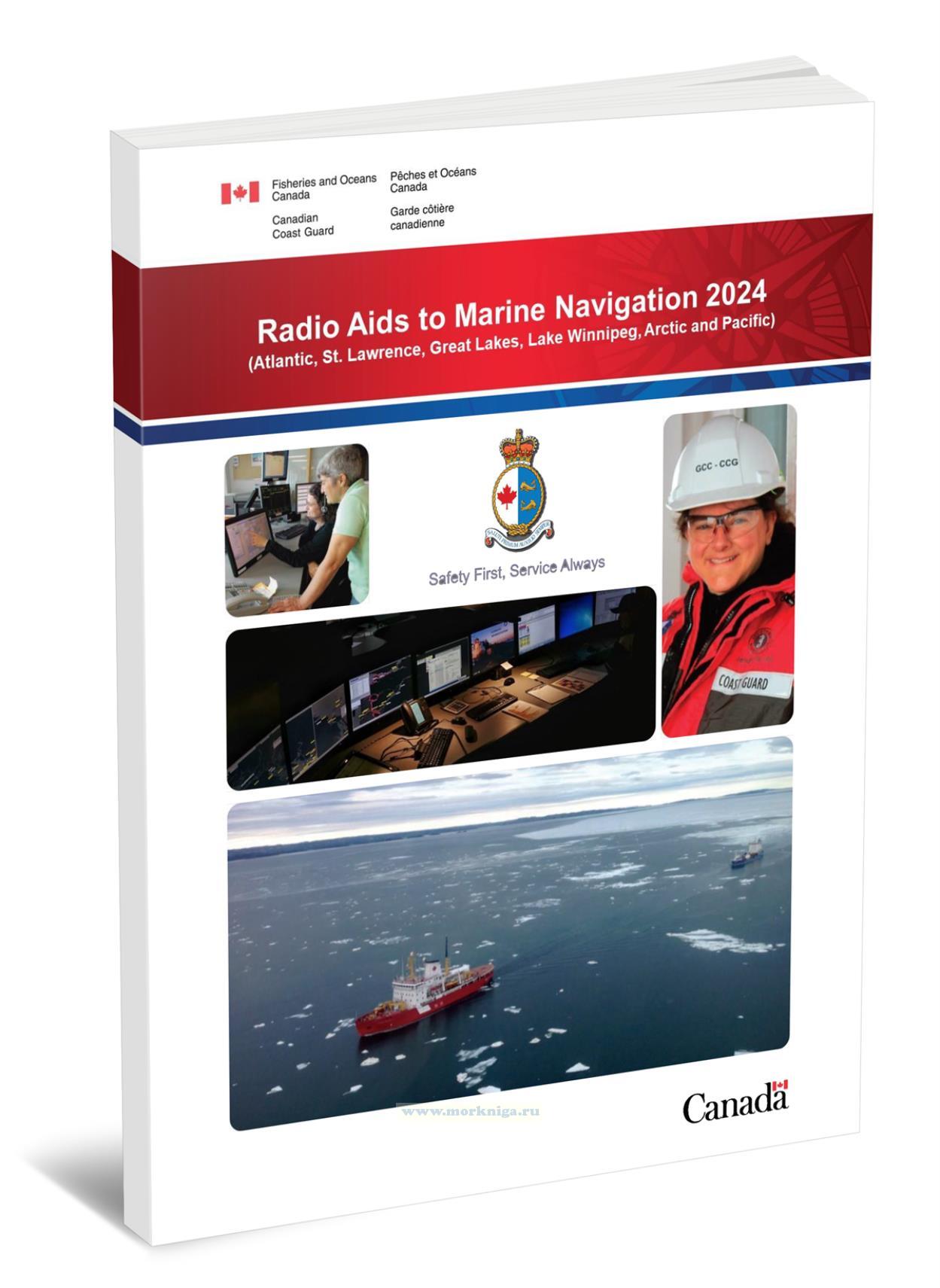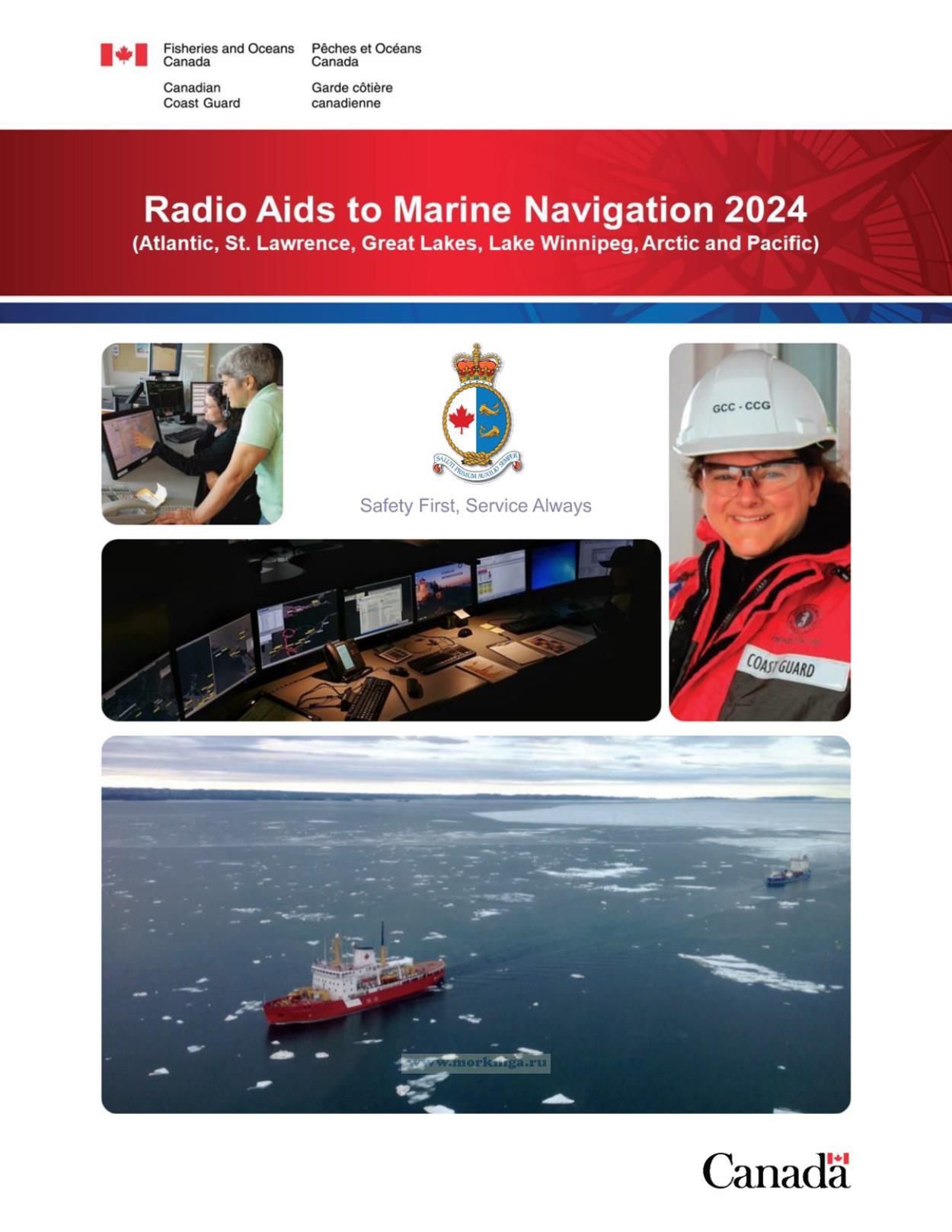Сб с 10 до 16
Radio Aids to Marine Navigation 2024 (Atlantic, St. Lawrence, Great Lakes, Lake Winnipeg, Arctic and Pacific)/Средства радиосвязи для морской навигации 2024 года (Атлантический океан, острова Святого Лаврентия, Великие озера, озеро Виннипег, Северный Ледовитый и Тихий океаны)
Книга на английском языке
This Radio Aids publication presents information in a convenient printed and bound paper format of the radio communication and radio navigational aids and services provided in Canada by Fisheries and Oceans.
Also included are radio facilities of other Canadian government agencies that contribute to the safety of all ships in Canadian waters.
This publication provides coverage of the Atlantic, St Lawrence River, the Great Lakes, Lake Winnipeg and the Eastern Arctic, and the Pacific.
Every ship station fitted on a Canadian ship or on a non-Canadian ship engaged in the coasting trade of Canada, pursuant to the Ship Station (Radio) Regulations 1999. Pursuant to the Charts and Nautical Publications Regulations, 1995, all ships in waters under Canadian jurisdiction are required to carry the most recent applicable edition of Radio Aids to Marine Navigation".
Contents
Part 1 Foreword
1.1 Advance Notices
1.1.1 Marine Mammal Protection
1.1.2 New Electronic Form for NORDREG Sailing Plan Reporting
1.2 Canadian Maritime Mobile Service Safety and Public Correspondence Communica Frequencies
1.3 General Information on MCTS Listings
1.4 Telephone / Facsimile / Telex Directory
1.5 Joint Rescue Coordination Centre (JRCC) / Maritime Rescue Sub-Centre (MRSC).
1.6 Icebreaking Services
1.7 Regional Office Addresses
1.8 Regional Navigational Warning (NAVWARN) Issuing Desks
Part 2 Facilities Information
2.1 Marine Communications and Traffic Services Centres
2.1.1 Halifax, Nova Scotia
2.1.2 Iqaluit, Nunavut
2.1.3 Labrador (Happy Valley-Goose Bay), Newfoundland and Labrador
2.1.4 Les Escoumins, Quebec
2.1.5 Placentia, Newfoundland and Labrador
2.1.6 Port aux Basques, Newfoundland and Labrador
2.1.7 Prescott, Ontario
2.1.8 Prince Rupert, British Columbia
2.1.9 Quebec, Quebec
2.1.10 Sarnia, Ontario
2.1.11 Sydney, Nova Scotia
2.1.12 Victoria, British Columbia
2.2 Canal and Lock Operations
2.3 Canal, Port and Lock Operations
2.4 Bridge Operations
2.5 Radio Beacon Stations Continuously in Operations
2.6 Radar Beacon (Racons)
2.6.1 Atlantic Coast, Gulf and St. Lawrence River (East of Montreal)
2.6.2 Central Area, including Great Lakes and the St. Lawrence Seaway (West of Montreal)
2.6.3 Pacific Coast
2.6.4 Arctic Coast and Archipelago
Part 3 Vessel Traffic Services
3.1 Canadian Coast Guard Responsibilities
3.2 Traffic Clearance
3.3 Communications
3.3.1 Communication Difficulties
3.3.2 Ship Board Radio Communications Equipment Malfunction
3.4 Offshore Systems
3.4.1 Zone Description
3.5 Local Vessel Traffic Services (VTS) Zones
3.5.1 Local Vessel Traffic Services (VTS) Zone Reports
3.5.2 Information Required
3.5.3 Entering a Zone
3.5.4 Variations from Requirement
3.5.5 Change in Information
3.5.6 Non-Routine Reports
3.6 Additional Reporting Requirements
3.6.1 Co-Operative Vessel Traffic Services (CVTS) Agreement
3.6.2 Western Canada - Turn Point Special Operating Area
3.6.3 Western Arctic - Mackenzie River Marine Safety Advisory Procedures
3.7 Zone Application
3.7.1 Offshore Systems
3.8 Advance Reporting Requirements
3.8.1 VTS Offshore Zone Report
3.8.2 ECAREG Zone Report
3.8.3 NORDREG Zone Reports
3.8.4 Pre-Arrival Information Report (PAIR)
3.8.5 West Coast - USA Notice of Arrival
3.9 Vessel Traffic Services Zone Schedules
3.9.1 Bay of Fundy
3.9.2 Halifax Harbour and Approaches
3.9.3 Northumberland Strait
3.9.4 Placentia Bay
3.9.5 Port aux Basques
3.9.6 St. John’s
3.9.7 St. Lawrence Waterway
3.9.8 Sarnia Zone and Areas
3.9.9 Strait of Belle Isle - Voluntary Zone
3.9.10 Strait of Canso and Eastern Approaches
3.9.11 Prince Rupert
3.9.12 Victoria
Part 4 General
4.1 Procedures
4.1.1 Radiotelephone Procedures
4.1.2 Distress Communications in Radiotelephony
4.1.3 Urgency Communications
4.1.4 Safety Communication
4.1.5 Aids to Navigation
4.2 Systems
4.2.1 Global Maritime Distress and Safety System in Canada (GMDSS )
4.2.2 Long-Range Identification and Tracking of Vessels Regulations (LRIT)
4.2.3 Emergency Position Indicating Radio Beacons (406 MHz)
4.2.4 Navigation Safety Regulations
4.2.5 Guidance for Masters in Distress Situations and Alerting of SAR Authorities
4.2.6 Procedure for Responding to DSC Distress Alerts by Ships
4.2.7 AMVER - Automated Mutual-Assistance Vessel Rescue System
4.2.8 Pre-Arrival Information Report (PAIR)
4.2.9 Reporting Marine Occurrences to Transportation Safety Board (TSB)
4.3 Services
4.3.1 Navigational Warning (NAVWARN) / (Notices to Shipping [NOTSHIP])
4.3.2 NAVTEX Services
4.3.3 World-Wide Navigational Warning Service (WWNWS)
4.3.4 Cellular Phone (*16) Service - Marine Emergencies
4.3.5 Direction Finding (VHF/DF) Service
4.3.6 Sailing Plan Service
4.3.7 Search and Rescue in Canadian Areas of Responsibility
4.3.8 Marine Communications and Traffic Services Message Service
4.3.9 Icebreaking and Ice Routing Services
4.3.10 Canadian Hydrographic Service (CHS)
4.3.11 Inspection of Radio Apparatus
4.3.12 Radio Station Licensing and MMSI Numbers
4.3.13 Marine Telephone Service
Part 5 Environment and Climate Change Canada’s Marine and Ice Warning and Forecast Programs
5.1 Background
5.2 Marine Weather Alerting Program
5.3 Marine and Ice Forecast Program
5.3.1 Monitoring the Forecast
5.3.2 Marine and Ice Forecast Areas
5.3.3 Current Conditions
5.3.4 Emergency Response
5.3.5 Delivery of Marine Warning and Forecast Services
5.4 Voluntary Observing Ship (VOS) Program
5.5 Buoys Program
5.6 Port Meteorological Officers (PMOs)
5.6.1 Port Meteorological Officers (PMOs)
5.7 NAVTEX
5.7.1 Abbreviations Used by MSC within NAVTEX and METAREAs Bulletins
5.7.2 Ice Elements
5.8 MAFOR Decode Table
5.9 Northern Canada
5.9.1 Marine Weather Forecast Program
5.9.2 Weather and Ice Messages
5.9.3 Weatheradio Canada
5.9.4 Marine Forecast Areas
5.9.5 Marine Forecast Service to METAREAs XVII, XVIII and Northwestern Section of METAREA IV (Hudson Bay and Approaches)
5.9.6 Serviced Forecast Zones
5.9.7 METAREAs Forecast Transmission
5.10 Newfoundland and Labrador
5.10.1 Marine Weather Forecast Program
5.10.2 The Regular Program
5.10.3 Marine Weather Observations and Forecast Bulletins
5.10.4 Weatheradio Canada
5.10.5 Marine Forecast Areas
5.11 Maritimes Region
5.11.1 Marine Weather Forecast Program
5.11.2 The Regular Program
5.11.3 The Recreational Program
5.11.4 Marine Weather Observations and Forecast Bulletins
5.11.5 Canadian Hurricane Centre
5.11.6 Weatheradio Canada
5.11.7 Marine Forecast Areas
5.12 Quebec Region
5.12.1 Marine Weather Forecast Program
5.12.2 The Regular Program
5.12.3 The Recreational Program
5.12.4 Marine Weather Observations and Forecast Bulletins
5.12.5 Weatheradio Canada
5.12.6 Marine Forecast Areas
5.13 Great Lakes Including St. Lawrence River to CornwallI
5.13.1 Marine Weather Forecast Program
5.13.2 The Regular Program
5.13.3 The Recreational Program
5.13.4 Buoys
5.13.5 Marine Weather Observations and Forecast Bulletins
5.13.6 Weatheradio Canada
5.13.7 Marine Forecast Areas
5.14 Pacific Coast
5.14.1 Marine Weather Forecast Program
5.14.2 Marine Weather Observations and Forecast Bulletins
5.14.3 Weatheradio Canada
5.14.4 Marine Forecast Areas
5.15 Canadian Ice Service (CIS)
5.15.1 Ice Forecasts
5.15.2 Ice Program
5.15.3 Ice Reports or Observations
5.15.4 Ice Charts
5.15.5 Weatheradio Canada
5.15.6 CIS Service to Marine Forecast Areas
5.15.7 Daily Ice Charts Broadcast
5.15.8 Facsimile Broadcast

